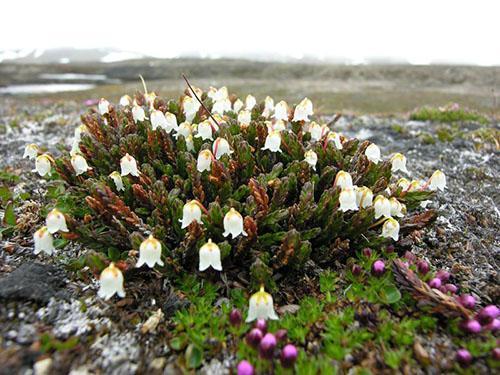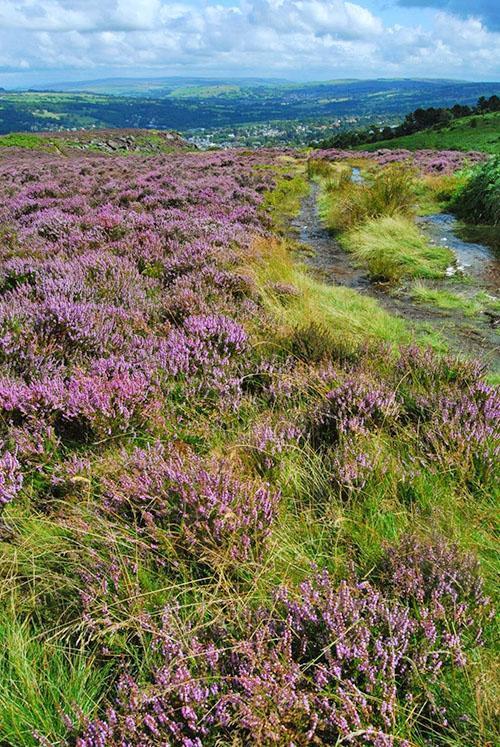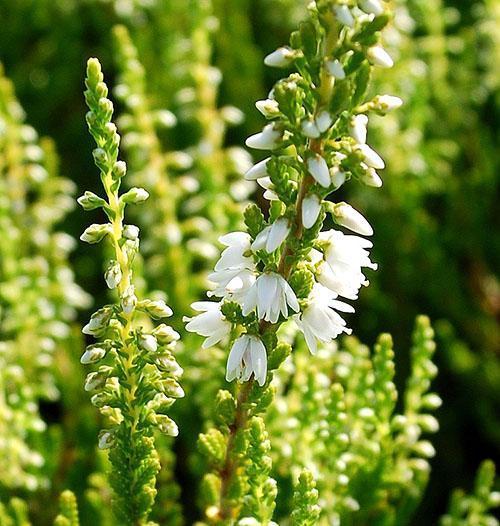Ornamental and forest heather: secrets of a hardy shrub
 At the mention heather the inhabitants of Scotland, Norway and other northern European countries represent small perennial shrubs 15 to 50 cm high with shoots densely planted with scaly leaves and small bell flowers of pinkish or lilac color.
At the mention heather the inhabitants of Scotland, Norway and other northern European countries represent small perennial shrubs 15 to 50 cm high with shoots densely planted with scaly leaves and small bell flowers of pinkish or lilac color.
Forest heather - a symbol of endurance and good luck

In one place it can exist for up to 40-50 years and is found even where other perennial crops simply cannot survive: in swamps and poor sandy soils of coniferous forests.
Low-growing species of forest heather adorn the meager flora in the tundra. For its unpretentiousness and resilience, the Norwegians in time immemorial honored the forest heather to become a symbol of the country, but in the gardens of Europe, an inhabitant of wind-blown hills began to appear only in the 18th century. In Russia, where up to 50 species belonging to this family are found in the wild, the heather garden appeared only twenty years ago on the basis of the Botanical Garden in Moscow.
In Scotland, the lucky man is said to have seen white heather flowers.
 Indeed, in the vast moorlands that are the country's traditional landmark, wild white heather is almost impossible to see. But today, when the plant has aroused well-deserved interest from gardeners, not only shrubs with tassels of white bells, but also varieties with raspberry, purple, yellowish and orange simple, as well as double flowers, are not uncommon.
Indeed, in the vast moorlands that are the country's traditional landmark, wild white heather is almost impossible to see. But today, when the plant has aroused well-deserved interest from gardeners, not only shrubs with tassels of white bells, but also varieties with raspberry, purple, yellowish and orange simple, as well as double flowers, are not uncommon.
Garden heather and related species
 Over the past 200 years, breeders have obtained several hundreds of spectacular varieties of decorative heather, which can be conditionally divided into low, medium and tall plants. Moreover, besides them, the closest representatives of the heather family are actively used in landscaping, for example, erika and wild rosemary, berry shrubs such as lingonberry, dove and blueberry, as well as rhododendrons.
Over the past 200 years, breeders have obtained several hundreds of spectacular varieties of decorative heather, which can be conditionally divided into low, medium and tall plants. Moreover, besides them, the closest representatives of the heather family are actively used in landscaping, for example, erika and wild rosemary, berry shrubs such as lingonberry, dove and blueberry, as well as rhododendrons.
Closest to the common heather are various types of erica, which live in nature from the Atlantic coast of America to the countries of North Africa. Wild heathers can be seen in the Asian region, the Caucasus and the Alps.
If the shoots of forest and decorative heather do not grow longer than 70 cm, then certain types of erika, for example, tree-like, are real trees, up to 5-7 meters high.
 Another difference between Erica and heather is needle-shaped small leaves and elongated flower cups. True heather differs from related species not only in appearance, but also in the timing of the appearance of buds. When the heather blooms, most of the ornamental plantings in the garden are already completing the growing season and preparing for winter. In the middle zone, only in the second half of summer, and more often in August, flowers open on the bushes, which, depending on the variety, can last until the snow cover is established.
Another difference between Erica and heather is needle-shaped small leaves and elongated flower cups. True heather differs from related species not only in appearance, but also in the timing of the appearance of buds. When the heather blooms, most of the ornamental plantings in the garden are already completing the growing season and preparing for winter. In the middle zone, only in the second half of summer, and more often in August, flowers open on the bushes, which, depending on the variety, can last until the snow cover is established.
In several European countries and in America, garden heather is an evergreen crop. The plant does not lose its decorative effect and perfectly tolerates mild winters with temperatures up to +8 ° C.
After the mass flowering is completed, the heather remains bright and, perhaps, the only decoration of the garden.In many varieties, the shoots are colored with all the colors of the rainbow, and the yellow, burgundy, purple or silvery foliage of the decorative heather is clearly visible on the area discolored in late autumn.
Reproduction and planting of decorative and forest heather
 You can propagate your favorite variety of terry, burgundy or white heather both with well-germinating seeds and vegetatively:
You can propagate your favorite variety of terry, burgundy or white heather both with well-germinating seeds and vegetatively:
- with the help of cuttings rooted in summer or autumn, in 1–1.5 months in light sandy soil, giving a root system suitable for planting;
- by means of layering from adult shoots of forest or decorative heather.
To obtain planting material at the point of contact with the soil, the branch is cut, treated with a growth stimulator, pinned and sprinkled with nutritious soil. By the fall, a young heather bush is ready for planting.
Varietal heather seedlings quickly take root, the root system of which is in a container with peat soil.
 Breeding and planting experts' recommendations:
Breeding and planting experts' recommendations:
- If garden heather bushes are not replanted by the end of September, it is better to postpone their transfer to a permanent place until April.
- For shrubs, it is better to choose a protected from the wind, illuminated area.
- Since heather grows with age, a distance of 40 to 50 cm is left from one plant to another.
- The depth of the planting pit for heather does not exceed 25 - 30 cm, but it is better to make it slightly wider, about 40 cm, in order to spread the roots.
- A drainage layer is arranged at the bottom.
- When filling the hole, it is important not to deepen the root collar.
Preparing soil for planting decorative heather
 But the main task of the gardener, who decided to plant decorative heather on the site, is to prepare the soil for this plant. Despite the unpretentiousness of the culture, in many cases the experience of growing heather ends in failure. The cause of death often lies in the fact that both forest and decorative heather live in symbiosis with primitive soil fungi, which form a whitish bloom or formations on the roots of the plant. If the mycelium of the fungus dies or is completely absent in the garden soil, the shrub weakens and may die.
But the main task of the gardener, who decided to plant decorative heather on the site, is to prepare the soil for this plant. Despite the unpretentiousness of the culture, in many cases the experience of growing heather ends in failure. The cause of death often lies in the fact that both forest and decorative heather live in symbiosis with primitive soil fungi, which form a whitish bloom or formations on the roots of the plant. If the mycelium of the fungus dies or is completely absent in the garden soil, the shrub weakens and may die.
 So, without taking urgent measures, the gardener cannot wait for the moment when the heather blooms on the site:
So, without taking urgent measures, the gardener cannot wait for the moment when the heather blooms on the site:
- To maintain the vital activity of mycorrhiza, an acidic soil with a pH of 4 to 5 units is needed, for artificial acidification of which 40 grams of garden sulfur, boric or citric acid are added per square meter.
- The soil mixture is made from two parts of the horse peat, one part of sand and the same volume of rotted needles or foliage.
- As a fertilizer during planting, you can add a complex mineral composition, without calcium and organic matter.
If there are coniferous plantings with blueberries nearby, it is useful to add sandy soil from under such vegetation to the mixture for planting decorative heather.
Garden heather care
 Preserve the moisture level in the soil, prevent it from overheating, and also prevent weeds from actively developing, allows soil mulching under bushes respond well to soil mulching. If shoots of weeds nevertheless appeared, so as not to damage the surface roots of the garden heather, it is better to carry out weeding only with your hands. On the eve of a set of buds, heather can be fertilized with a granular complex fertilizer at the rate of 10-15 grams per plant.
Preserve the moisture level in the soil, prevent it from overheating, and also prevent weeds from actively developing, allows soil mulching under bushes respond well to soil mulching. If shoots of weeds nevertheless appeared, so as not to damage the surface roots of the garden heather, it is better to carry out weeding only with your hands. On the eve of a set of buds, heather can be fertilized with a granular complex fertilizer at the rate of 10-15 grams per plant.
To maintain the acidity of the soil and prevent the ingress of chlorine and calcium, dangerous for mycorrhiza, to the roots, rain, filtered and acidified water is used for irrigation, for which 3-4 grams of citric, boric or oxalic acid are added to a 10 bucket.
 In the first two years of life, decorative heather does not need pruning; on adult bushes, in the spring, not only last year's inflorescences are cut off, but also the entire green part of this branch to wood, as well as frozen and dry shoots.
In the first two years of life, decorative heather does not need pruning; on adult bushes, in the spring, not only last year's inflorescences are cut off, but also the entire green part of this branch to wood, as well as frozen and dry shoots.
If, when planting, all the features of this interesting culture are taken into account, the varieties are selected taking into account the timing of flowering, frost resistance and growth, then late autumn, when the heather blooms, will become the brightest season in the garden. The extremely durable and hardy shrub will show itself in all its glory, and all the efforts of the gardener will definitely pay off.